Newsletter No. 225 October 3, 2016
ANOTHER NAZI SCAM: RUDOLF HESS’S PROTOTYPICAL BLOOD ORDER
Sold by the German auction house for €7,600, the above badge has variously been described as the prototypical Blood Order or the Stoßtruppe Adolf Hitler Badge. The catalogue description stated: “Heß’s personal example, Hitler’s present to the 9 November 1933. Silver, hollow-stamped, fineness mark “990”, maker’s mark “Jos. Fuess München”. Obverse Feldherrnhalle surmounted by an eagle, lateral laurel branches with year ciphers “1923” and “1933”. Reverse dedicatory engraving “PG R. Hess – München 9. Nov. 1933 – A. Hitler”. Silver vertical attachment needle. Dimensions 46 x 42 mm, weight 27 g. In an old black velvet case formed as an SS-Traditionsmütze. Additional Feldspange belonging to Heß with the three classes of the NSDAP-Dienstauszeichnung and a black armband. Provenance: Private Property Southern Germany.
“Of great rareness. Only four other examples are known of this commemorative or prototype issue: that of Heinrich Himmler (depicted and described among others by Jörg Nimmergut, Deutsche Orden und Ehrenzeichen bis 1945, supplemental volume, pp. 218), that of Emil Maurice (cf. K.D. Patzwall in “Militaria”, no. 1, vol. 24 Jan/Feb 2001, pp. 9), Hitler’s personal exemplar (Hermann Historica, auction 59, 15 April 2010, lot 7269) and that of Johann Singer (Hermann Historica, auction 63, 29 October 2011, lot 4073).
These were issued – according to Maurice – on the eve of the 10th anniversary of 9 November 1923 to the men of storm troop “Hitler” and, as one may conclude from the issue to Himmler, to other high-ranking party functionaries. On Hitler’s decision at the beginning of 1934 on a new design for the Blood Order (decree of wearing permissions and specifications dated 11 February 1934) wearing this “unofficial” issue was forbidden. Due to the small number issued, and only to high-ranking officials, the bestowed orders presumably have not been recalled.”
As the catalogue blurb stated, the Hess badge was cased and accompanied by the ribbon bar said to have belonged to Hess. The case is modelled on the ‘coffee can’ kepis worn by SS men in the early days. The lining of the lid bears the legend ‘ges. gesch’ in lower case, which seems anomalous.
Of the five known surviving examples, Hermann Historica had auctioned three since 2010: Hitler’s example in 2010 for €21,000, Johann Singer’s example in 2011 for €5,800 and Rudolf Hess’ badge in 2013 for €7,600. The other two examples are engraved to Emil Maurice and Heinrich Himmler. The Emil Maurice badge was featured in the January/February 2001 issue of Militaria magazine, in an article by Klaus D. Patzwall (Right). Jörg Nummergut’s 2001/2002 edition of Deutsche Orden und Ehrenzeichen bis 1945 referenced the award on Page 218, as the Hermann Historica catalogue mentioned.
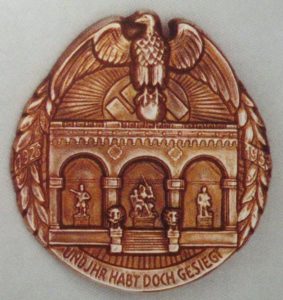
The letter from Emil Maurice to which Hermann Historica referred is dated 16.2.1962. Maurice states therein that this award was commissioned from the Munich firm of Josef Fuess and awarded soley to men of the Stoßtruppe Adolf Hitler, as well as political leaders convicted and jailed with Hitler after the failed coup d’état on 9.11.1923: “…dieses Ehrenzeichen nur an die Männer des Stoßtrupps “Hitler” sowie deren polititisches Führer, die bei dem Hitlerprozeß der Volksgerichts in München verurteilt und die Strafe auch auf der Festung Landsberg abgesessen haben, verleihnen warden solute.”
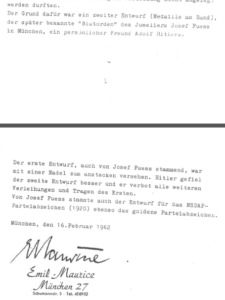
Maurice stated in his letter that Hitler’s personal friend Josef Fuess subsequently produced a new design consisting of a medal on a ribbon and that Hitler, finding it an improvement on the badge, forbade the wearing of the pin-back badges he had awarded on the eve of the tenth anniversary of the Munich Putsch. Hitler’s interdiction would explain, of course, why none of the hundred or so Putsch veterans thought by Emil Maurice to have received the badge were ever photographed wearing it, despite the fact that three months elapsed between the award of this special Honour Badge by Hitler on 8.11.1933 and his formal institution of the Blutorden as we know it in February 1934.
On 15.9.2007, the American collector Bob Coleman stated a thread on the Wehrmacht Awards forum to show off his Emil Maurice grouping, which included Maurice’s “Stosstruppe Blood Order Badge”, as Coleman described it. The grouping also included the above-referenced letter said to have been written in 1962 by Maurice. Coleman wrote: “The Stosstruppe Blood Order Badge. In The Grouping, There Is A Letter From Maurice Describing This Badge As The Original Designed Blood Order. During The Period Of Time They Were Being Manufactured By Fuess, Hitler Decided To Redesign The Blood Order In To A Medal And Broaden The Award. Each Badge Was Awarded To A Stosstruppe Member. On The Reverse Is The Name Of The Recipient. I Will Not Show The Reverse Of This Badge Due To The Fact That I Do Not Want To Aid Fakers In Replicating This Rare Badge. According To The Maurice Letter, The Badges Were Awarded But Never Were To Be Worn.”

However, Coleman did post a photograph of the reverse of the badge elsewhere and a reader was kind enough to supply a copy for this article. The Emil Maurice badge on the left is the one featured in Militaria magazine in 2001 and the badge on the right is the one acquired by Coleman. Between 2001 and 2007, the 990 silver hallmark managed to migrate from the righthand to the lefthand side of the reverse although the other details remain very similar.
The same day, well-known American collector and dealer Bob Hritz (right)
 chimed in, writing: “Having been priveledged to examine this group, at Bob’s. I must say that I think this is the most important political group I have ever seen. The interaction of Maurice and Hitler, as young men after WWI, and that Hitler trusted Maurice as his driver and bodyguard. As the plot thickens, Maurice has twists and turns, but is never abandoned, by Hitler; although lesser men may have done so.” The following day, Mr Coleman added this statement: “One Final Note, In Maurice’s Notes On The Stosstruppe Blood Order Badge, He Noted They Were Awarded The Evening Of 9 November, 1933, Commemorating The 10th Anniversary Of The Putsch. One Of Our Other Colleagues On This Forum Also Owns One Of These Badges That He Posted Previously In Another Forum. One Day, We Had A Chance To Compare The Two Side By Side When We Met For Coffee.” The “Colleague” [sic] to whom Coleman was referring was none other than Hritz, owner of the badge allegedly awarded to Johann Springer, seen above with the Hess badge reportedly sold in November 2013 for €7,600. The badges belonging to the two Bobs were indeed the same.
chimed in, writing: “Having been priveledged to examine this group, at Bob’s. I must say that I think this is the most important political group I have ever seen. The interaction of Maurice and Hitler, as young men after WWI, and that Hitler trusted Maurice as his driver and bodyguard. As the plot thickens, Maurice has twists and turns, but is never abandoned, by Hitler; although lesser men may have done so.” The following day, Mr Coleman added this statement: “One Final Note, In Maurice’s Notes On The Stosstruppe Blood Order Badge, He Noted They Were Awarded The Evening Of 9 November, 1933, Commemorating The 10th Anniversary Of The Putsch. One Of Our Other Colleagues On This Forum Also Owns One Of These Badges That He Posted Previously In Another Forum. One Day, We Had A Chance To Compare The Two Side By Side When We Met For Coffee.” The “Colleague” [sic] to whom Coleman was referring was none other than Hritz, owner of the badge allegedly awarded to Johann Springer, seen above with the Hess badge reportedly sold in November 2013 for €7,600. The badges belonging to the two Bobs were indeed the same.
On 26.9.2007, the historian and author Michael Miller, reminded the forum that Himmler was never a member of the Stoßtruppe Adolf Hitler after someone made a reference to “Himmler’s Stosstruppe Badge”. Coleman jumped in to field Mr Miller’s comment: “Maybe I Can Clear Up The Issue With Regards To Himmler. Maurice Stated In His Letter Regarding This Badge That It Was Also Given To Selected Party Members Who Were Prosecuted Following The Failed Putsch. This Would Explain Himmler Receiving A Badge”. When Miller replied that Himmler had never been prosecuted for his part in the Putsch nor for any offence during the Weimar period, Coleman responded the following day in capitals, which equate to shouting in terms of netiquette: “I GUESS STANDING AT THE BARRICADES AND HOLDING THE FLAG ON 9 NOVEMBER, 1923 WOULD QUALIFY HIMMLER FOR THIS BADGE. HE WAS THERE AND PART OF THE PUTSCH.”
In stepped Hritz to calm things down: “The badge is really shrouded in mystery. We can find no photos of them being worn and no history of any urkunde for them. The best we have is the letter that was written by Emil Maurice where he mentions the badge. I cannot understand why Himmler would have one, other than because, by 1933, Hitler had placed his faith and trust in Himmler and Roehm was already losing Hitler’s favor. However, this is only speculation. We only know of the badge being given, by Hitler, on 9 November, 1933, months before the first awards of the blood order. This is known through the Maurice letter. I look forward to learning of other examples and learning more about this ellusive badge. Perhaps we will, one day, find a photo of the pin back award being worn, between Nov 1933 and April 8, 1934, when the first official Blood Orders were given. It took over a year to award all of them.”

Wait a minute! The 1962 letter from Emil Maurice stated that Hitler had forbidden the wearing the badge he had awarded to Putsch veterans on the eve of the 10th anniversary of the attempted coup because the medal produced by Fuess — known as the Type 1 Blood Order — was better than the badge. So now we are looking at a five-month period in which not a single recipient of the badge was photographed wearing it. To digress, it is hardly surprising that Hitler found the medal an improvement on the badge, which is definitely not up to the standards one would expect of a firm like Fuess.
Bob Coleman followed up: “I Hope The Following Quote (translated) from The Maurice Letter Aid In The Understanding Of This Badge. “It Was Orignally Intended That This Badge Of Honor Would Be Awarded To The Men Of The Stosstrupp”Hitler” As Well As Their Political Leaders Who Had Been Found Guilty In The Trial After 9 Novemeber(Hitlerprozess)and Who Had Servered Their Sentence In Fortress Landsberg Am Lech. Maurice Further Elaborates “The Badge Was Intended For These Prisoners(Those Held In Landsberg) And For A Few From The Surrounding Milieu Of The Political Leadership. To The Best Of My Knowledge, About 100 Examples Of The Badge Were Awarded Which Were Then Not To Be Worn Once Awarded.”He Goes On To Say That The Design Could Be Worn In The Form Of A Stickpin.” Coleman’s command of German was proving even shakier than his command of English. The alleged Maurice letter is quite clear in stating that the Blood Order could be worn as a stickpin, presumably on one’s lapel or through one’s tie when in civilian dress. However, this referred to the medal rather than the badge.
From here on, the thread descended into pure farce. Responding to another member of the Ooohhh-Aaahhh participants, Coleman two-fingered the following revelation: “To The Best Of My Knowledge, Maurice Lived Out The Balance Of His Life Quietly In Munich. This Grouping Came Out Of The Family After Much Inner Fighting. I Understand One Of His Sons Is A Practicing Orthodox Jew And Wanted The Nazi Items From His Father’s Past Sold. That Is Why They Reside With Me Instead Of In Munich.” It is common knowledge that Emil Maurice, having been treated relatively leniently, serving just four years in a labour camp from 1948 to 1952. He died in 1972. It is also well-known that Maurice was Jewish. Meanwhile, Bob Hritz had posted his Johann Springer nachlaß, which included Springer’s Stoßttruppe Adolf Hitler 1923 cuff title, his Blood Order, and the badge promoted as the precursor of the Blood Order.
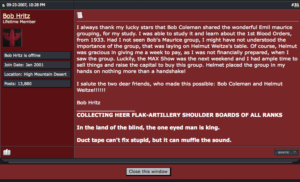
Coming back to Hermann Historica’s reported sale in November 2013 of the Rudolf Hess badge for €7,600, a source who preferred to remain anonymous but described himself as close to Weitze wrote in recently to say that the buyer, having asked Helmut Weitze
for an opinion before actually parting with his money, had refused to pay after being told: “Also wir schauen und wir staunen. Dieses Blutorden würde ich nicht in meiner Sammlung haben möchten.” or, in English: “So we looked at it and we are amazed. I wouldn’t want to have this Blood Order in my collection.” If the source is reliable, it would seem that Mr Weitze no longer stands behind these badges that appeared in collecting circles some seven decades after they were said to have been made, and some forty years after Emil Maurice’s alleged letter of 1962 revelling their existence.
Like Bob Coleman’s Emil Maurice’s badge, the Johann Springer badge was said to have come directly from the Springer family. At some point, Bob Hritz quietly moved this important historical relic on, as it was sold in October 2011 by Hermann Historica for €5,800. As for the Maurice badge, Bob Coleman has not responded to more recent questions about it and about other objects in the grouping he so proudly showed off back in 2007. According to the afore-mentioned source, the Emil Maurice grouping came from different sources, including Poland, and was sold by Ray Zyla of Mohawk Arms in the United States on behalf of Helmut Weitze to a collector named Tracy Speicher. When Speicher realised that that the grouping was liberally salted with fakes and fantasy pieces, like the alleged Blood Order prototype, he sold it on to an unsuspecting collector: Bob Coleman. The source went on to allege that Bob Hritz was one of the shills involved in promoting these fantasy pieces on various militaria forums. As for Helmut Weitze, it would not be the first time he has been accused of using other dealers to pass questionable memorabilia into the collecting world. Those of you who recall the enormous scandal after George Petersen found out that his Paul Conrath Knight’s Cross documents were faked will remember that the vendor who claimed to Petersen that he had acquired them from the Conrath family later accused Helmut Weitze of conning him into selling the documents to Petersen.
WCS
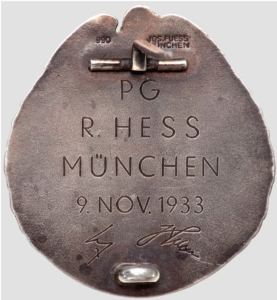
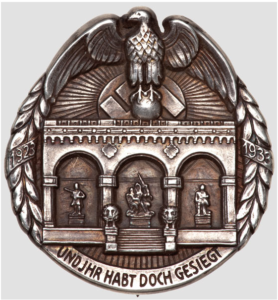
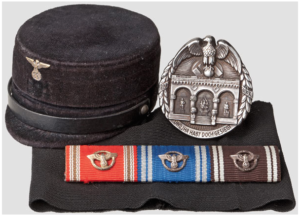
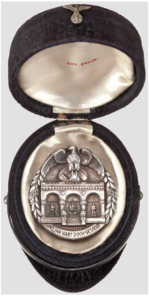
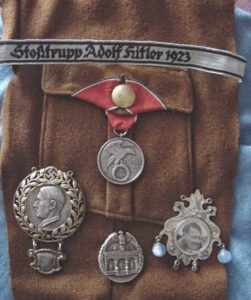
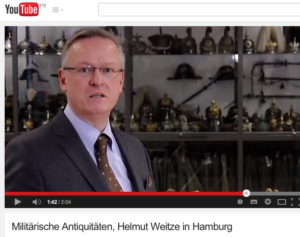
8 thoughts on “Newsletter No. 225 October 3, 2016”
Now you are after the big boys again. What about that howlingly funny one about the WAF and its founders? Why not put that up next? These idiots in full throat remind me of feeding time at the local zoo’s monkey house.
M
The WAF, and its rival forum sites, are indeed noisome.
These forums were set up to control collectors, stop negative comments about fakes and let crooked dealers show off their wares for the dim of wit and large of purse.
The concept worked…for a time but now its day is done.
A
why is bob coleman still allowed to frequent these forums, he knowingly passed on fake items yet still nothing happened to him on waf or wrf, what an arsehole
The collection worlds are almost always controlled by a group of dealers and advanced collectors whose basic idea is to get, and keep, power and to engage in commerce. The German militaria collecting world has the WAF as its mouthpiece. It is run by a mixture of very crooked dealers and equally crooked collectors. If one wishes to sell or collect, one must be an approved member or be shoved outside and not only ignored but most often insulted and denigrated. I find the chatter on the WAF to be more like the clucking of chickens than anything else but they damage the collecting world just as surely as the maker and sellers of SS bookplates, Feldherrnhalle honor daggers or fake belt buckles. The best place for these creeps would be a deep quarry or a cage at the zoo where they can entertain and feed the tigers. ADR
well maybe mr coleman should be up for fraud as he has knowingly sold on all the fakes in the maurice collection as original
That collection, the “Maurice Collection” is filled with bad fakes and relatively worthless. It is floating around now, waiting for a sucker to bite. ADR
trouble is somebody will buy it
There are people who will buy anything. Logic or common sense have nothing to do with it. A collector I know bought half a pair of field glasses because a dealer told him it had belonged to a general with one eye. Or another collector who bought what he fondly believed were SS General Demelhuber’s boots. Why? Because the name was written, with pencil, in one one the boots. Absolute proof! The best deals are between collectors who know what they have, what they want and the difference between reality and dreams.A